New Zealand
About Andrew Cusack
 Writer, web designer, etc.; born in New York; educated in Argentina, Scotland, and South Africa; now based in London.
Writer, web designer, etc.; born in New York; educated in Argentina, Scotland, and South Africa; now based in London. read more
News
Blogs
Reviews & Periodicals
Arts & Design
World
France
Mitteleuropa
Knickerbockers
Argentina
The Levant
Africa
Cape of Good Hope
Netherlands
Scandinavia
Québec
India
Muscovy
Germany
Academica
A Gothic Library for Christchurch
Christchurch, the oldest city in New Zealand, was known for its gothic cathedral before the February 2011 earthquake destroyed its spire. Modern architects, as voracious a species as ever existed, descended upon the city like a plague, declaring that everything traditional must be demolished and hideous glass hulks raised instead. They succeeded in convincing the city’s Anglican authorities to deconsecrate the cathedral (despite remaining mostly intact) and plans for its future remain vague.
Local architectural designer & engineer James Carr has come up with a proposal to build a central library for Christchurch on Cathedral Square. The design complements the gothic cathedral (or whats left of it) and would be a handsome addition to the city.
More whimsical perhaps is Mr Carr’s idea to build a gothic rugby stadium in Christchurch.
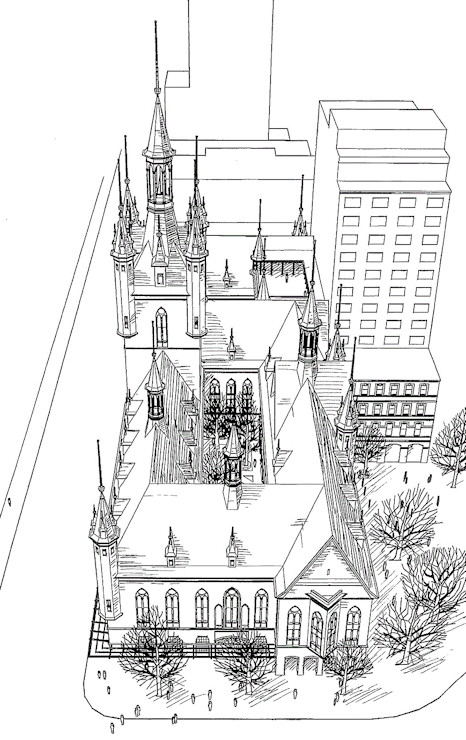
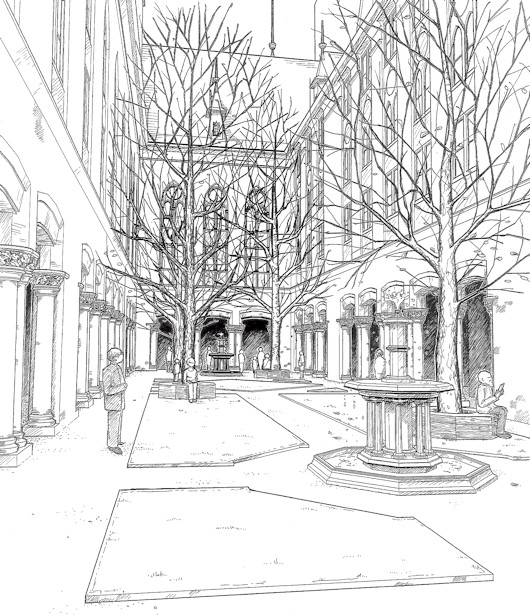

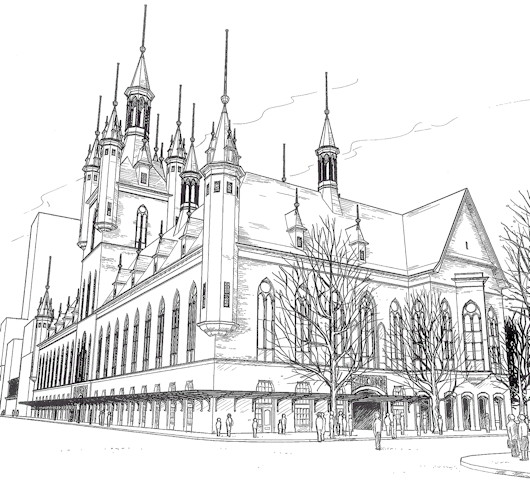
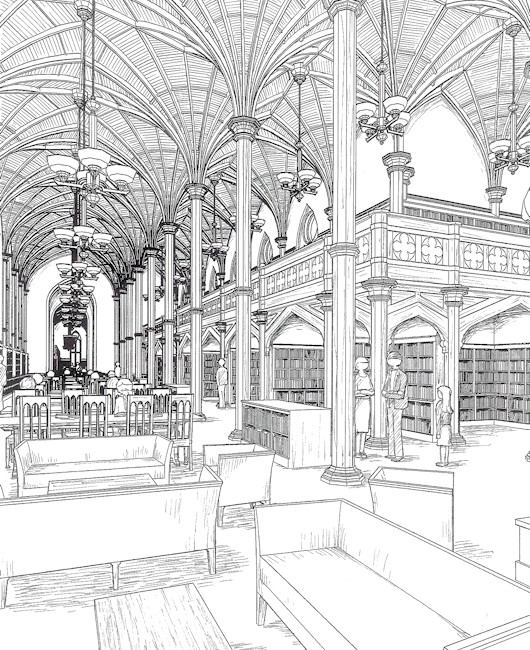
A Maori in Buenos Aires
The Argentine stopover of Te Pēhi Kupe
So 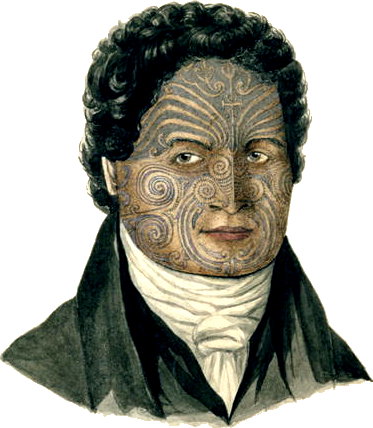 far as I can tell, the first Maori to visit Argentina (or the United Provinces of the River Plate as it was then called) was the young nobleman Te Pehi Kupe in October 1824. (The name is spelt varyingly as Te Pēhi Kupe, Tupai Cupa, Te Pai Kupa, and Tippahée Cupa). Te Pehi was born on the North Island, probably around 1795, and was a senior-line descendant of Toarangatira (founder of the Ngati Toa tribe) as well as an uncle to the more famous Ngati Toa chief, Te Rauparaha.
far as I can tell, the first Maori to visit Argentina (or the United Provinces of the River Plate as it was then called) was the young nobleman Te Pehi Kupe in October 1824. (The name is spelt varyingly as Te Pēhi Kupe, Tupai Cupa, Te Pai Kupa, and Tippahée Cupa). Te Pehi was born on the North Island, probably around 1795, and was a senior-line descendant of Toarangatira (founder of the Ngati Toa tribe) as well as an uncle to the more famous Ngati Toa chief, Te Rauparaha.
Most of New Zealand was a bit of a mess at the time, as various Maori tribes fought each other for land to grow potatoes on. Te Pehi Kupe, being a chief and military leader, was desirous to go to Europe in order to obtain weapons for his tribe. When the British ship Urania went past the southern tip of the North Island, Te Pehi forced himself aboard despite the violent resistance of the ship’s officers and crew. When asked what he desired by the Urania‘s captain, Richard Reynolds, Te Pehi replied in broken English, “Go Europe, see King George”.
Captain Reynolds did not think this a good idea and, knowing the Maori to be good swimmers, tried to have him thrown overboard, but the native nobleman’s physical strength prevented this. (And a good thing, too, as Te Pehi managed to save the Captain from drowning later on in the journey.)
The Urania made its return to England with Te Pehi Kupe aboard, calling at Lima and then sailing around the Southern Cone, where they called in at Buenos Aires. George Thomas Love provides us with an account of the Maori’s arrival in A Five Years’ Residence in Buenos Ayres (published in 1827):
In the month of October, 1824, the visit of a New-Zealand chief to Buenos Ayres, by name Tippahée Cupa, attracted much curiosity; he arrived in the British ship Urania, Captain Reynolds. Tippahée came alongside this ship in Cook’s Straits, with a war canoe filled with his people, and, in spite of the remonstrances and even force used by Captain R. refused to quit the vessel, expressing his determination to proceed to England. He bade his followers an affectionate adieu, enjoining obedience to his successor during his absence. The Urania sailed for London with her passenger the 8th December, 1824.
Tippahée, when he first arrived in Buenos Ayres, was clothed in an old red coat, formerly belonging to a London postman. The English paid him many attentions, inviting him to dine at their houses, and new clothing him. His behaviour at table was easy and unembarrassed; and, when requested, he would perform the dances and war songs of New Zealand. He understood a little of the English language, and spoke a few words of it; his intelligent manners, and circumspect conduct, rendered him an universal favourite.
On the map he could trace the ship’s course from New Zealand to Lima and Buenos Ayres. He knew an Englishman immediately; the Spaniards he did not much admire, fancying they viewed him with contempt, and was glad to get among Englishmen. His age is about forty; he possesses amazing strength; his tattooed face and appearance always attracted a crowd after him in Buenos Ayres.
On board ship he was found very useful, doing all sorts of work, but he positively declined to go aloft. The fate of Captain Thompson, and the crew of the British ship Boyd, ought to bespeak caution in using coercion with these savage chieftains of New Zealand.
In Cruise’s book of New Zealand, Tippahee was shewn a picture of a chief of his country, with which he was greatly delighted. The object of his journey to England is to solicit arms and ammunition, to place him upon a par with a rival chief, who possesses those requisites.
In England, Te Pehi was indeed presented to King George IV. He also learned to ride, visited factories, was given many gifts, and survived the measles before leaving England aboard the Thames on 6 October 1825. In Te Pehi’s absence abroad, peace had been agreed between the Ngati Toa and their Ngati Apa rivals. Ngati Toa eyes soon turned to the South Island, and during the military campaign there Te Pehi Kupe was killed, his body cooked and eaten, and his bones turned into fish hooks.
Still, at least he enjoyed Buenos Aires before he died.
Opening Parliament Down Under
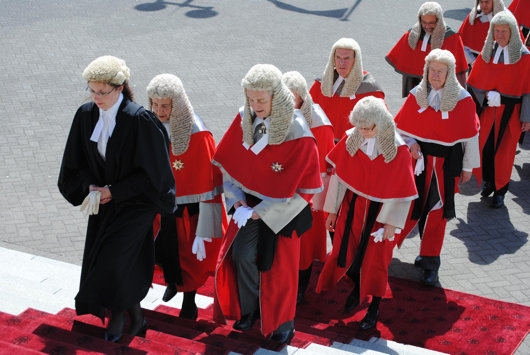
I’m a fan of state openings of parliament, so it might be a surprise that I’ve never been to one. I did see some of the practice run-through for the State Opening in Cape Town (which involves a delightful parade of the Cape Town Highlanders and other units from the Castle to Parliament) but unfortunately a social occasion kept me from the actual opening itself. As my luck would have it, I managed to return to live in Blighty again the one year the blasted Government decided not to have a State Opening. Roll on, 2012! Anyhow, down in the Antipodes, the New Zealanders have just had their State Opening of Parliament in the realm’s capital city of Wellington. (more…)
Best Universities in the World
From north to south, a completely arbitrary and biased accounting
WHILE UNIVERSITY rankings within countries have been popular for some time now, especially in the United States and United Kingdom, it’s only been in the past decade or so that worldwide rankings of universities have come to the fore. The most widely known is probably the Academic Ranking of World Universities produced by Shanghai Jiaotong University, alongside the QS World University Rankings from the firm Quacquarelli Symonds, and the T.H.E. World University Rankings from the weekly magazine Times Higher Education. All such ratings employ varying statistical matrices and methods of divination obscure to the outsider but which, one supposes, must have some form of merit. They are more useful for gaining a general impression of the place of a university rather than comparing and contrasting two or more particular institutions.
The aforementioned ranking structures are rather to formal for us to gain all that much knowledge from. Personal interactions, reputation, age, style of architecture, and other such factors carry much greater import when I judge universities. Oxford and Cambridge, whether you like it or not, are still the top universities in the world, even if they might not be our favourites. You just can’t beat them. While they might not be as much fun as other places, they come closest to achieving the balance of age, tradition, interesting people, serious research, good location, and general niftiness.
For a certain type of person, Harvard remains paramount among American universities, but to be a Harvard undergrad has carried a certain social stigma in our quarters for the past two or three decades. Harvard Business School, however, remains perfectly acceptable. In the Ivy League, Yale, not Harvard, is king, followed by Brown (not thanks to its radical professoriate but rather due to the strong Continental infiltration amongst its studentry). Dartmouth is the fun #3 of the Ivies, while the rest are forgettable (well, Princeton’s not bad really — it has the Whitherspoon Institute — but Cornell, Columbia, and Penn are yawn-worthy).
Up to this point, we have been speaking generally, but there are topical institutions of course. If you really must study ‘business’, then there’s Harvard Business School or INSEAD. Are there any other business schools of actual note? In the military realm, Sandhurst is the unquestionable king. The École royale militaire in Brussels is up there — being Catholic, Francophone, and monarchic attracts good elements from outside Belgium. In the States, there is the Citadel and VMI, but not much else (the federal ‘service academies’ have poor reputations except for Annapolis). One doesn’t hear much about Saint-Cyr these days.
Speaking of France, the reason one can’t come up with proper rankings is because some institutions or groups of institutions would be entirely outside it. The grandes écoles are the best example. They are superbly elitist, the absolute top, but they mostly exist in that little French world, with all its delights and limitations.
But for ‘topical’ institutions, the University of London has plenty: SOAS, LSE, the Cortauld, the various institutes of the School of Advanced Study, etc., etc.
There are also those interesting little schools of art history and conservation, attached to museums like the V&A or auction houses like Sotheby’s and Christie’s. The École du Louvre, however, must be the queen regnant of these schools.
Charles Taylor’s presence at McGill alone makes it worthy of note, but one suspects there are other strengths at the university. At any rate, it is still a perfectly respectable place to be an undergraduate. Boston College is also quite strong at the postgrad level, except in the theology school where heresy is widely believed to be thriving. Given the wealth and particularity of America’s universities, there are small and unknown centres of excellence in many unexpected places (for example the quite strong literary translation centre at the University of Rochester).
Rome’s universities of both church and state have shabby academic reputations but still attract for being Roman. One always hears seminarians complaining about the Gregorian, but no one can never really complain about Rome, and being a student or a seminarian is as good a reason to be in Rome as any. Rome also has John Cabot University, an ‘American’ institution divided between Americans on their semester abroad and the full-timers (often the layabout members of larger European families, who also frequent the American University of Paris).
And of course many of the Italian universities are not so much places of learning as conspiracies for the avoidance of unemployment on the part of their academics and administrators. Regrettably, much Italian talent moves abroad for higher salaries and better working conditions (Cavalli-Sforza, to name but one, at Stanford), but the handful of scuoli superiori (e.g. the Scuola Normale in Pisa) still maintain their dignity.
In Spain, Salamanca is well-regarded, and there are a number of newer, private, properly Catholic entities that have been created. Of course, Opus Dei are very proud for having created the University of Navarre ex nihilo. Portugal, meanwhile, has yet to recover from the Marques de Pombal’s disastrous eighteenth-century reform of Coimbra.
If you’re one of those people who actually wants a proper education then, for better or worse, you must go to America. Thomas Aquinas College in California and St. John’s College in Maryland might be the last genuine places of higher learning in the European world. Attempts are being made to found a British Catholic version, and many imitations (Catholic, Protestant, and secular) exist around the United States.
If I could name some other honorable mentions in addition to those featured below, I would add Dublin (Trinity, that is), Bristol, the Collège d’Europe, Leiden, Leuven, Utrecht, Uppsala (and all the old Scandos), Heidelberg (and a dozen other German universities), King’s Halifax, Trinity College in Toronto, some parts of Berkeley, York for graduate study but not undergrad, the C.E.U. in Budapest (despite being a Soros project), and Exeter and Warwick aren’t bad really. Some universities, like the Jagiellonian in Kraków or the Charles in Prague, must be mentioned due to age, but I have to plead ignorance as to any knowledge of their current state.
I’m probably leaving out a dozen places that deserve a mention but I’ve forgotten; such are the limits of our fallen human nature. Here follows, arranged from northernmost to southernmost, our completely arbitrary and biased accounting of the six best universities in the world. (more…)
The New Zealand Half-Crown
In the 1930s, New Zealand devalued its pound in relation to sterling and a whole new series of coinage and bank notes were introduced under the authority of the Reserve Bank of New Zealand. The government commissioned the accomplished English numismatic artist George Kruger Gray to design the dominion’s new coinage, which included this very handsome half-crown. It’s a splendid convergence between Maori and European design, two cooperating strains of New Zealand’s national culture. The country’s shield of arms is topped by a Tudor crown and flanked by indigenous motifs. (more…)
Antipodean Heraldic Philately
One of my favourite series of stamps comes from New Zealand. In 1929, the New Zealand Post Office commissioned the Englishman H. L. Richardson, an artist and teacher at the Wellington Technical College, to design a series of fiscal revenue stamps, or duty stamps. The design employed the New Zealand coat of arms in a variety of colours depending on the value of the stamp. Richardson erroneously had the lion in the crest of the arms hold aloft a New Zealand flag instead of the Union Jack that he was supposed to carry. The crest was changed to a crown in 1956 (along with a series of other changes) to signify that New Zealand had by then become a sovereign realm of its own. Richardson’s stamps were withdrawn from use in 1967 when New Zealand’s currency was decimalised. (more…)
Olympic Teams of Yesteryear
The vanished lands and failed alliances of the Modern Olympiad
THE GAMES OF THE Modern Olympiad are events which are meant to bring the peoples of the world together in peace and harmony and all those good and heartening things, but from the very beginning they have gotten bogged down in the petty particularities of rival nations, which altogether makes them rather more fun and interesting, if perhaps a touch less high-minded. The story of the ancient gathering’s revival in 1896 through the efforts of Pierre Frédy, Baron de Coubertin is well-known. Athletes from at least fourteen countries participated in those first modern games in Athens over a century ago, though the concept of national teams was not introduced until the 1906 games (the Intercalated Games, which have since been de-recognised by the IOC). But since those first games towards the end of the nineteenth century, the fortunes of many lands have waxed and waned, and likewise the spirit of unity amongst various peoples vied with the spirit of distinctiveness. Here, then, are but a small sample of Olympic teams which once vied for gold but which can no longer be found among the Olympic competitors of today. (more…)
The Would-Be King of New Zealand
Brigadier the Right Honourable Sir Bernard Fergusson,
Baron Ballantrae, KT, GCMG, GCVO, DSO, OBE
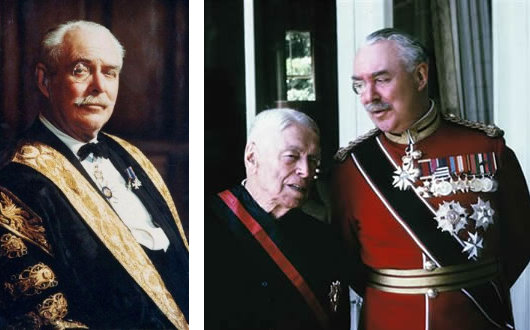
Left, Lord Ballantrae in his robes of office as Chancellor of the University of St Andrews; Right, as Governor-General of New Zealand with former Prime Minister Sir Walter Nash.
Over at Curated Secrets, Stephen Klimczuk takes a brief wander through Clubland, mentioning the illustrious Bernard Fergusson, who was known for “the skill with which he could toss his monocle in the air and catch it in his eye”. Stephen’s co-author on Secret Places, Hidden Sanctuaries, the Much Hon. Laird of Craiggenmaddie, chimes in on the commentbox, bringing to light that “when he was serving under Orde Wingate with the Chindits in Burma, among the supplies dropped by the RAF to those doughty warriors was a supply of monocles for Fergusson, since the damage/loss rate was so high in the jungle.”
Fergusson has always fascinated me, not only because he was the Chancellor of my university, but also because he has the best claim to the throne of New Zealand should the Land of the Long White Cloud ever decide to dispense with the House of Windsor. Lord Ballantrae (as Fergusson was ennobled) served as Governor-General of New Zealand, his own father served as Governor-General of New Zealand, and both his grandfathers served as Governor of New Zealand before the antipodean kingdom became a dominion. Rather appropriately, his son and heir is currently serving as Her Majesty’s High Commissioner to New Zealand, which is now the highest office of the British government in those islands.
Stephen mentions other fun stories of Clubland, such as the waggish response of the dinner guest who was kept waiting for Hermann Goering at one club before the war: “‘I have been shooting,’ said Goering. ‘Animals, I hope?’ was the quite reasonable question in response.”
Swanndri
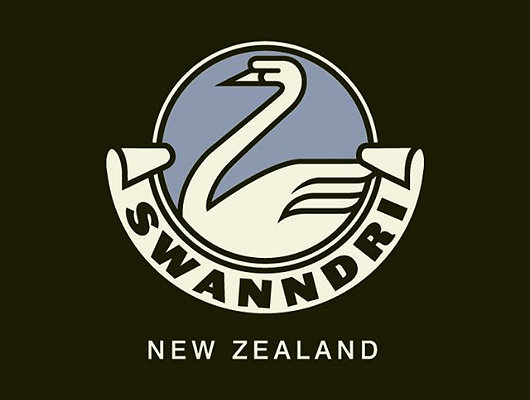
Founded in 1913, this New Zealand outdoor clothing company advertises: “We have to make a good garment. Most of our customers have guns.” Their classic heavy woollen garment with a lace-up section at the neck has been a favourite of Kiwi farmers for decades, but the firm now produces clothing for city-dwellers and outdoor adventurers as well.
I just like their logo.
New vice-regal flag for New Zealand

Elizabeth II, Queen of New Zealand, recently approved a new vice-regal flag (above) for her governor-general, His Excellency the Honourable Anand Satyanand, PCNZM, QSO, KStJ. The flag has a blue field charged with the shield from the coat of arms of Her Majesty in Right of New Zealand, topped by St. Edward’s crown. The previous flag (below) was of the standard viceregal type for the British Commonwealth of Nations, depicting the crest from the British royal arms with a scroll bearing the name of the dominion.
His Excellency, incidentally, is the first Catholic governor-general in the history of New Zealand.

Search
Instagram: @andcusack
Click here for my Instagram photos.Most Recent Posts
- In the Courts of the Lord February 13, 2025
- American Exuberant February 10, 2025
- Crux Alba Journal Launch February 10, 2025
- The Year in Film: 2024 February 10, 2025
- Articles of Note: 27 January 2025 January 27, 2025
Most Recent Comments
- on When an American aristocrat meets a European Grand Duke
- on The Year in Film: 2024
- on Jesuit Gothic
- on The Borough Synagogue
- on No. 82, Eaton Square
- on Christ Church
- on The Last Will and Testament of Louis XVI
- on Amsterdam
- on Season’s Greetings from the Seventh
- on Season’s Greetings from the Seventh
Book Wishlist
Monthly Archives
Categories


